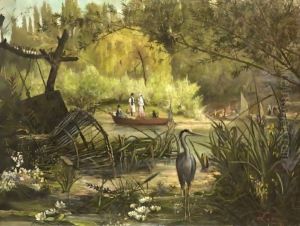Ludovic-Napoleon Lepic Paintings
Ludovic-Napoleon Lepic was a French artist known primarily for his contributions to etching and for his work as a painter. Born into an aristocratic family on December 17, 1839, in Paris, France, Lepic was originally destined for a career in the military. However, his passion for the arts led him to pursue a different path.
Lepic studied under the tutelage of the prominent French painter Charles Gleyre and later under the famous Édouard Manet. Under Manet's influence, he became associated with the Impressionist movement, though his style remained distinctive. Lepic is often remembered for his appearance in Manet's well-known painting 'Boating', where he is depicted alongside Manet's brother-in-law, Rodolphe Leenhoff.
Lepic's interest in etching revived the medium in France, which had been overshadowed by other forms of printmaking. He was innovative in his approach to etching, often experimenting with techniques and introducing the 'eau-forte mobile' (mobile etching), which allowed for variations in prints, making each one unique. His etchings often depicted scenes of everyday life, landscapes, and marine views, reflecting both his interest in the natural world and his aristocratic upbringing, which afforded him opportunities to travel.
As an artist, Lepic was also involved in the research of prehistoric art and archaeology. He was one of the first to recognize the importance of prehistoric cave drawings as significant works of art. His interests in this field led him to write and illustrate books on the subject, contributing to the early study of Paleolithic art.
Lepic's influence extended beyond his artistic works. He was known to host salons that were frequented by influential artists and intellectuals of the time. These gatherings helped to promote the exchange of ideas and fostered the development of the Impressionist movement.
Ludovic-Napoleon Lepic's contributions to art and etching were significant, though he is less well-known today compared to some of his contemporaries. He passed away on October 27, 1889, leaving behind a legacy that includes his innovative techniques in etching, his role in the early study of prehistoric art, and his influence on the Impressionist circle of his time.
